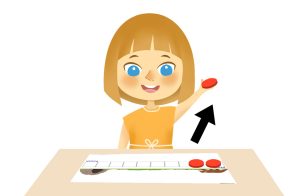 Four-year-olds Juanita and Ezra play a math activity that involves counters, dice, game cards, and a game board featuring a number path. Juanita rolls a 3, so she needs to put three blue counters on the number path. Next, Ezra rolls a 2 and needs to place two red counters in the first two spaces of the number path, even though Juanita’s blue counters are in those spaces. The children continue to take turns adding counters or taking away some counters, depending on whether they draw a plus or a minus card. The goal is to continue until the number path is filled with red and blue counters. [The activity described here is from the DREME Guided Small Group Math Activity: Get the Animals Home]
Four-year-olds Juanita and Ezra play a math activity that involves counters, dice, game cards, and a game board featuring a number path. Juanita rolls a 3, so she needs to put three blue counters on the number path. Next, Ezra rolls a 2 and needs to place two red counters in the first two spaces of the number path, even though Juanita’s blue counters are in those spaces. The children continue to take turns adding counters or taking away some counters, depending on whether they draw a plus or a minus card. The goal is to continue until the number path is filled with red and blue counters. [The activity described here is from the DREME Guided Small Group Math Activity: Get the Animals Home]
What Are Cognitive Flexibility Skills? How Are They Used in Number Activities?
Cognitive flexibility is the ability to consider several approaches to solving a problem, think about a situation in different ways, and shift between tasks. In the vignette, cognitive flexibility supports each child’s need to periodically shift between counting up (adding) or counting down (subtracting) chips from one turn to the next.
There are many ways for teachers to support children’s cognitive flexibility while learning about numbers. For example, when playing activities that require switching between adding and subtracting, children may benefit from using Plus/Minus cards.
Plus/Minus Cards
In the DREME Guided Small Group Math Activity: Get the Animals Home, the number path is like a number line because children can count up to move closer to the animals’ home or count down to move farther from home. Using this number path may prompt children to count up, count down, or use both strategies to solve the problem or check their work.
The Plus/Minus cards support children’s cognitive flexibility when they play Get the Animals Home because they provide visual reminders to switch from one mathematical operation to another. Another DREME Guided Small Group Math Activities, Cookie Game, also uses Plus/Minus Cards to promote cognitive flexibility.
Why Focus on Cognitive Flexibility?
Being flexible to new strategies is important when learning math because sometimes children’s first idea does not work or is inefficient. For example, if in the next turn, Juanita rolls a 2 and, as a result, puts two additional counters on the game board, she might use the “counting from 1” approach to figure out that she has five counters in all. But if she is instead prompted to count on from three, Juanita might learn to think of different approaches to solve a problem. This cognitive flexibility helps dispel the myth that there is only one right way to do a math problem.
The DREME Guided Small Group Math Activities were intentionally designed to involve shifting from one concept or strategy to another (for example, addition or subtraction) or to encourage thinking about multiple solutions to a math problem so children can simultaneously practice their math and executive function skills.
Cognitive flexibility is only one of the many related abilities that make up executive function (EF). Other EF skills include sustained attention, inhibitory control, and working memory. To learn about these skills and their relevance to numbers and counting, see the additional DREME articles on executive function and math.